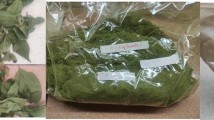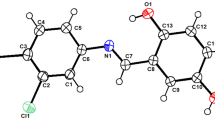Abstract
Phenylboron(III) and triorganolead(IV) derivatives of the types PhB(OH)(DTCZ), PhB(DTCZ)2, and Ph3Pb(DTCZ) (where DTCZ− is the anion of a S-benzyldithiocarbazate ligand) have been synthesized by the substitution reactions of phenylboronic acid and triphenyllead chloride with S-benzyldithiocarbazate. The resulting complexes have been characterized by elemental analyses, molecular weight determinations, and conductivity measurements. The mode of bonding has been established on the basis of infrared and 1H, 13C, and 11B NMR spectroscopic studies. Probable tetrahedral and trigonal bipyramidal structures for the resulting derivatives have been proposed. The X-ray powder diffraction study of the compound [PhB(OH)(L1)] was carried out in order to have an idea about the molecular symmetry of the compound. The results show that the compound belongs to the orthorhombic crystal system. In the quest for better fungicides and bactericides, the studies were conducted to assess the growth inhibiting potential of the synthesized complexes against various fungal and bacterial strains. The studies demonstrate the concentration reached levels which are sufficient to inhibit and kill the pathogens. The antimycobacterial effects of the organolead(IV) compounds were also examined. The results obtained indicated that the compounds display antimycobacterial activity.
Similar content being viewed by others
References
Heath, O.V.S. and Clark, J. E., Nature, 1957, vol. 178, p. 600.
Bioinorganic Chemistry, Raymond, K.N. (Ed.), Washington: A.C.S., 1977.
Ali, M.A. and Livingstone, S.E., Coord. Chem. Rev., 1974, vol. 13, p. 101.
Ali, M.A. and Bose, R., J. Inorg. Nucl. Chem., 1977, vol. 39, p. 265.
Tarafder, M.T.H. and Ali, M.A., Can. J. Chem., 1980, vol. 58, p. 727.
Tarafder, M.T.H., Ali, M.A., Saravanan N., et al., Transition Met. Chem., 2000, vol. 25, no. 3, p. 295.
Tarafder, M.T.H., Ali, M.A., Wee, D.J., et al. Transition Met. Chem. 2000, vol. 25, no. 4, p. 456.
Degaonkar, M.P., Gopinathan, S., and Gopinathan, C., Synth. React. Inorg. Met.-Org. Chem., 1989, vol. 19, p. 613.
Biyala, M.K., Fahmi, N., and Singh, R.V., Main Group Met. Chem., 2004, vol. 27, p. 181.
Fahmi, N., Jadon, S.C.S., and Singh, R.V., Phosphorus, Sulfur, and Silicon, 1993, vol. 81, p. 133.
Biyala, M.K., Fahmi, N., and Singh, R.V., Indian J. Chem., A, 2004, vol. 43, p. 1662.
Kumari, A., Singh, R.V., and Tandon, J.P., Phosphorus, Sulfur, and Silicon, 1993, vol. 66, p. 195.
Chaudhary, A., Agarwal, M., and Singh, R.V., Appl. Organometal. Chem., 2006, vol. 20, p. 295.
Tomioka, H. and Namba, K., Kekkaku, 2006, vol. 81, no. 12, p. 753.
Mahajan, K., Fahmi, N., and Singh, R.V., Indian J. Chem. A, 2007, vol. 46, p. 1221.
Gaur, S., Maanju, S., Fahmi, N., and Singh, R.V., Heterocycl. Commun., 2005, vol. 11, p. 411.
Vogel, A.I., A Text Book of Quantitative Inorganic Analysis, London: Longman, ELBS, 1989.
Vogel, A.I., A Textbook of Practical Organic Chemistry, London: Longman, ELBS, 1978, p. 323.
Chaudhary, A., Mahajan, K., and Singh, R.V., Appl. Organometal. Chem., 2007, vol. 21, p. 117.
Singh, R.V., Mittal, S.P., Swami, M., and Mahajan, K., Int. J. Chem. Sci., 2007, vol. 5, p. 1417.
Saxena, C. and Singh, R.V., Main Group Met. Chem., 1992, vol. 15, p. 31.
Singh, V.P., Singh, R.V., and Tandon, J.P., J. Inorg. Biochem., 1990, vol. 39, p. 237.
Abu El-Reash, G.H., Taha, F., Shallaby, A.M., and El Gamal, O.A., Indian J. Chem., A, 1991, vol. 80, p. 286.
Barba, V., Santillan, R., and Farfan, N., J. Mex. Chem. Soc., 2005, vol. 49, p. 211.
Singh, R.V. and Biyala, M.K., Phosphorus, Sulfur, and Silicon, 2006, vol. 181, p.1.
Kumari, A., Tandon, J.P., and Singh, R.V., Appl. Organomet. Chem., 2004, vol. 7, p. 655.
Tweedy, B.G., Phytopathology, 1964, vol. 55, p. 910.
Jadon, S.C.S., Gupta, N., and Singh, R.V., Indian J. Chem., 1995, vol. 34, p. 733.
Mohanan, K. and Murukan, B., Synth. React. Inorg. Met.-Org. Chem., 2005, vol. 35, p. 837.
Author information
Authors and Affiliations
Corresponding author
Additional information
The article is published in the original.
Rights and permissions
About this article
Cite this article
Swami, M., Mahajan, K., Arya, S. et al. Organoboron(III) and organolead(IV) complexes as antimicrobial and antimycobacterial agents: Synthetic, structural, and biological aspects. Russ J Coord Chem 35, 373–380 (2009). https://doi.org/10.1134/S1070328409050108
Received:
Published:
Issue Date:
DOI: https://doi.org/10.1134/S1070328409050108




